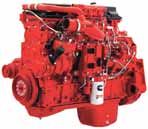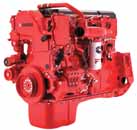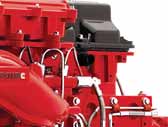 Intent on capturing a larger share of the U.S. market, Tognum subsidiary MTU recently opened an engine assembly
Intent on capturing a larger share of the U.S. market, Tognum subsidiary MTU recently opened an engine assembly
factory in Aiken County, South Carolina, USA. The Aiken facility will build MTU Series 2000 and 4000 diesels,
many of which are used in various types of mobile mining equipment. (Photo courtesy of Tognum/MTU).
The driving force behind all of this
activity is the tiered series of diesel emissions
regulations initiated 13 years ago by
the U.S. Environmental Protection
Agency. The EPA’s “Tier” standards 0
through 4 have been generally mirrored by
the European Union’s Stage I through IV
standards. With the latest (Tier 4, Stage
IIIB) regulations poised to take effect at
the turn of the year, these standards, as
applied to off-road engines and described
by a recent backgrounder report released
by the Diesel Technology Forum—a supplier-
supported diesel advocacy organization—
require progressively lower allowable
emissions of nitrogen oxides (NOX) and
particulate matter. “It is a complex system
and its compliance dates are based on
engine power rating as well as other factors,”
the report notes, and as E&MJ
researched this article, one engine expert
joked, “Nope, Tier 4 compliance isn’t
rocket science…it’s actually much more
complicated than that stuff.”
The Tier 4 standards offer manufacturers
a provisional step (Interim Tier 4, or 4i)
that stipulates a certain level of emissions
particulate-matter emissions, followed by a
final step, starting in 2014, that dictates
additional cuts in NOX and HC emissions.
Overall, Tier 4 essentially requires manufacturers
to reduce emissions to levels anywhere
from 50% (NOX) to 90% (PM) lower
than the current generation of diesel
engines. However, Tier 4 emissions
requirements apply only to new products
and are not retroactive to existing
machines or equipment. Engines or dieselpowered
equipment designated for export
outside the U.S. also aren’t affected by Tier
4 regulations, although some manufacturers
have stated as a matter of policy they’ll
only offer appropriate Tier/Stage-compliant
engines to all of their global customers
regardless of location.
 Sequential “Tier”regulations are aimed at reducing diesel-
Sequential “Tier”regulations are aimed at reducing diesel-
generated
NOX, hydrocarbon and PM emissions drastically.
Although Tier 4/Stage IV standards
apply to all off-road diesel engines—with
the exception of those used in underground
mining and certain other nonmining applications—
the immediate focus is on
engines rated up to 750 hp (560 kW),
because Tier 4i/Stage IIIB standards
immediately impose noticeably higher limits
on this range than on the much higherhorsepower
units that are the workhorses of
mine loading and haulage. The midrangesize
diesels affected typically are used to
power wheel loaders, bulldozers, road
graders, smaller rigid-body and articulated
haul trucks, hydraulic excavators, drills,
and other types of mobile support and utility
equipment as well as stationary equipment
(crushers, gensets, etc.)
 Common emission-control technologies for off-road diesel applications. Emissions: HC-Hydrocarbons,
Common emission-control technologies for off-road diesel applications. Emissions: HC-Hydrocarbons,
PM-Particulate
Matter, NOX-Nitrogen Oxides, CO-Carbon Monoxide.
• The type of fuel and lubricating oils
required, and what is actually available;
• The amount of additional technician
training required;
• The extent of additional maintenance
attention required;
• Engine durability, reliability, power and
performance characteristics;
• Actual cost increases (early estimates
predicted the cost increase to install
additional emissions control for most
equipment would be on the order of 1%
to 3% of equipment price, although
more recent estimates are in the low double-
digit range; while the cost of low-sulphur
diesel fuel could raise fuel prices by
seven cents per gallon); and
• Real-world effectiveness in helping to
reduce an operation’s carbon footprint.
E&MJ addressed a number of these
issues a year ago (See “High-horsepower
Diesel Design Revs Up to Meet Tighter
Emissions Standards,” December 2009, p.
72). Over the past year, engine builders have
introduced literally dozens of new models in
the ≤750-hp range that are Tier 4i/Stage IIIB
certified. This article recaps some of these
new products with relevance to mining.
Making Introductions
Engine suppliers used the bauma 2010
trade show held in April to showcase the
technologies they’ve selected to comply
with Tier 4i/Stage IIIB standards, as well as
an opportunity to reassure both existing
and prospective customers that newly certified
engine designs
wouldn’t come with
unpleasant surprises in
performance, fuel consumption,
maintenance
and other considerations.
Suppliers
included, Caterpillar,
Cummins, MTU, Volvo,
Deere Power systems,
Perkins (a Caterpillar
subsidiary) and Deutz
displayed diesel units
for both mobile and
stationary mining,
quarrying and construction
applications,
and made concerted
efforts to educate and
assist product stakeholders
in assessing
future engine-selection
strategies—a complicated
prospect, as
indicated by the
accompanying chart.
 Choosing the proper emissions control strategy requires a wide range of choices
Choosing the proper emissions control strategy requires a wide range of choices
and assessments by all involved—the engine builder, equipment OEMs and end
users. (Source: “Off-road Diesel Vehicle Emission Regulations–Trends and
Challenges,” R. Shet and N. Shetty, Tata Consultancy Services.)
Because no single technology can
reduce all regulated emissions to the levels
demanded by Tier 4 final standards,
manufacturers have selected from a laundry
list of available technologies to suit
their corporate requirements and objectives.
In a recent white paper titled Offroad
Diesel Vehicle Emission Regulation–
Trends and Challenges, researchers from
Tata Consultancy Services provided
thumbnail descriptions of each major
supplier’s core Tier 4 strategy. Excerpts
follow:
“Caterpillar will continue to follow its
ACERT technology path and build Tier
4 on it. The core concept behind
ACERT technology is advanced combustion.
The combustion process is
carefully controlled to reduce pollutant
levels, while maintaining performance
and efficiency. To meet Tier 4 requirements,
Caterpillar is focused on deepmachine
integration, electronic controls
and aftertreatment. Caterpillar’s
Tier 4 engine systems will be equipped
with PM after-treatment technology,
including oxidation catalysts and diesel
particulate filters with advanced regeneration
systems that will optimize
uptime, fuel efficiency and operator
convenience. The engines will not use
SCR to meet Tier 4 interim regulations.
CNH, a Fiat subsidiary, uses externally
cooled EGR coupled with DPF for lowersize
engines. This solution meets emission
targets at low cost and with limited
impact on vehicle space requirements.
Medium to large vehicle applications
go with SCR as such machines
will have less space constraints. SCR
has been selected as it offers significant
operating cost reduction compared
to other technologies, lower maintenance
cost and excellent engine performance
and fuel consumption. Adding to
above technologies, the engines come
with common rail elec-tronic injection
and two-stage turbocharging.
Cummins’ Tier 4 Technology includes
High Pressure Common Rail (HPCR),
Variable Geometry Turbocharger (VGT),
advanced electronic controls, cooled
Exhaust Gas Recirculation (EGR) and
Diesel Particulate Filter (DPF). The
engines will be also equipped with a
crankcase filter which eliminates
escaping blow-by gases, oil mist and
droplets. The Cummins Tier 4 product
range will maintain or increase power
outputs compared with Tier 3.
Deere Power Systems starts with its
proven Tier 3 PowerTech Plus engine platform
as foundation and adds a DOC/DPF
unit for reducing particulates. NOX is controlled
by increasing the percentage of
cooled EGR. PowerTech Plus technology
uses four-valve heads, cooled EGR, vari
able-geometry turbochargers (for more
precise combustion-air management), air
to air aftercooling and a new electronic
control module.
Volvo’s V-ACT (Volvo-Advanced Combustion
Technology) includes a highpressure
fuel system, fixed-geometry
turbochargers, switchable internal EGR,
new camshafts, enhanced electronic
control and new coolers. It expects to
meet Tier 4 with the addition of diesel
particulate filters, which is the technology
it used to meet on-road regulations.”
Missing from these descriptions is mention
of an early 2010 announcement by
Komatsu America that it was implementing
new diesel technology that meets Tier 4i
standards. Based on Komatsu proprietary
technologies, this approach is claimed to
reduce exhaust gas particulate matter by
more than 90% and NOx by more than
45% when compared with current Tier 3
levels, while still consuming less fuel.
Komatsu’s Tier 4 engine technology
includes a newly designed variable geometry
turbocharger; diesel particulate filter,
heavy duty high-pressure common rail fuel
injection system, a larger and more robust
cooled EGR system, redesigned combustion
chamber at top of piston, and a harmonized
engine and machine interface by
means of electronic control. Komatsu said
it has integrated the technology into mining
engines ranging in size from 3.3 to 46
liters, including those it jointly develops
and builds with Cummins.
Presenting the Certified
Collection
Caterpillar, using its proprietary ACERT
technology as a foundation, has implemented
next-generation turbocharging,
advanced electronics, advanced fuel systems,
particulate aftertreatment systems
and a suite of NOX reduction technologies
to provide Tier 4 emissions solutions. In
February 2010 Caterpillar introduced five
new Tier 4i/Stage IIIB Industrial engines.
the C13, C15, C18, C27 and C32. These
ACERT technology engines cover a power
range of 385–1,200 bhp (287–895 bkW).
The new C13 ACERT is a 12.5-liter-displacement
engine and delivers 385-475
bhp (287-354 bkW). It is claimed to provide
torque up to 1,604 lb-ft (2171 Nm),
is electronically controlled and features a
mechanically actuated electronic fuel
injection (MEUI) system and asymmetric
turbocharger.
The 15.2-liter C15 delivers 475–580
bhp (354–433 bkW) and provides improved
lower end power density compared
with the Tier 3/Stage IIIA configuration.
The C18 is an 18.1-liter displacement
model that delivers 600–765 bhp
(448–571 bkW); depending on power
requirements, either single asymmetric or
series turbocharging is used. Cat said
power density for the 765-bhp (571-bKw)
rating has been significantly increased
over the Tier 3/Stage IIIA model and it
does not require aftertreatment. The C15
and C18 are built on a common core platform
and share similar physical dimensions.
According to Cat, a C18 800-bhp/
597-bkW model will be available only in
Tier 4 Final configuration.
The C27 ACERT is a 27-liter, 800–
1,050 bhp (597–783 bkW) unit and,
according to Cat, can easily be integrated
into OEM equipment powered by Cat’s Tier
2 configuration or a competitive model. It
produces maximum torque of up to 3,539
lb-ft (4798 Nm) and features side-mounted
asymmetric turbochargers and a
mechanically actuated electronic fuel
injection (MEUI) system. The C32, a 32.1-
liter displacement model producing 950–
1,200 bhp (708–895 bkW), is equipped
with side-mounted asymmetric turbochargers.
Both engines are built on a common core platform and do not require aftertreatment
to achieve Tier 4i emissions.
In April 2009, Cat introduced the C7.1,
a 7-liter family with a power rating of
175–300 hp (130–225 kW) and peak
torque of 944 lb-ft (1280 Nm). That
engine includes Cat’s Clean Emissions
Module (CEM) aftertreatment system to
meet Tier 4i/Stage IIIB emissions standards.
Cat said it is designed to allow
OEMs maximum flexibility in mounting the
aftertreatment module in a wide variety of
locations depending on the application.
Equipped with a next generation A5 electronic
control unit, high pressure common
rail fuel system and a two-stage Smart
Wastegate turbocharger, Cat claims the
new C7.1 ACERT engine delivers excellent
low-speed response and torque as well as
superior power density at higher speeds.
Fuel consumption improvements of up to
5% have been realized compared with
equivalent Tier 3/Stage IIIA engines.


 Cummins’ new QSX11.9 (left) and QSX15 (middle)Heavy-Duty engine duo, introduced earlier this year, feature
Cummins’ new QSX11.9 (left) and QSX15 (middle)Heavy-Duty engine duo, introduced earlier this year, feature
the engine builder’s
latest technology designed to efficiently power mining equipment in the 300- to 600-hp
(224-447 kW) range.
Cummins announced in September it
was commencing production and supply of
its Tier 4i and EU Stage IIIB compliant
QSB6.7 and QSL9 engines. The QSB6.7 is
certified to a power output of 300 hp (224
kW), while the QSL9 engine offers output of
400 hp (298 kW).
Tognum subsidiary MTU Friedrichshafen
used the bauma event to highlight
its compliance plan, which it said is
designed to meet all foreseeable future
emissions standards. The program involves
engines up to 730 kW for Tier 4 (from
2014) as well as engines below 560 kW for
Stage IIIB and Tier 4 interim and includes
its Series 400, Series 500, Series 900,
Series 2000 and Series 4000 engines producing
100 kW to 3,000 kW.
Ten- and 12-valve Series 1600 engines
for mining applications will extend MTU’s
product line up to 730 kW. These meet
EPA Tier 4 requirements by using EGR and
do not need diesel particulate filters or SCR
units. MTU has placed particular emphasis
on optimizing the combustion process in
these engines, and has raised injection
pressure to 36,000 psi and incorporated
two-stage intercooled turbocharging.
 The 10- and 12-valve versions of its Series 1600 engines will extend MTU’s mid-range off-road
The 10- and 12-valve versions of its Series 1600 engines will extend MTU’s mid-range off-road
engine product line up to 730 kW for mining applications.
To comply with Stage IIIB and Tier 4i
standards, MTU will equip these engines
with an integrated SCR unit. This technology,
according to MTU, was selected after
consultation with major customers and
allows OEMs to convert their vehicles and
equipment for 2011 emissions targets with
the least possible outlay. This approach also brings additional benefits in the form
of reduced fuel consumption.
Further tweaking of its larger Series
2000 and Series 4000 engines to comply
with Tier 4i and Tier 4 final standards, said
the company, will primarily be aimed at the
U.S. market. The first public introductions
of these engines will occur at trade events
taking place in the U.S. in 2011.
In October, Volvo Construction Equipment
reported that it had received Tier 4
interim emissions certification Volvo D13
(13 liter) and Volvo D16 (16 liter) engines.
EPA certification for the D11 (11 liter)
engine was received in August 2010. The
EPA-certified D11, D13 and D16 Tier 4i
engines with V-ACT (Volvo-Advanced Combustion
Technology) feature high-pressure
variable fuel injection systems, cooled exhaust
gas recirculation (EGR), precise variable-
geometry turbo (VGT) turbocharger
controls, and a new engine management
system (EMS). The Volvo electronic control
unit (ECU) controls the entire EGR process,
managing the mix of recirculated
exhaust gas and fresh air crucial to the
reduction of PM and NOX emissions while
maintaining performance and fuel economy.
And, because reduction of diesel particulate
matter is a major objective of Tier
4i, the new Volvo engines also employ an
exhaust after-treatment system that reduces
particulate matter by 90%.
John Deere Power Systems said its
PowerTech PVX 6.8L engine above 130 kW
(174 hp) and PowerTech PSX 6.8L engine
had been certified as compliant with Tier
4i and Stage IIIB regulations. The
PowerTech PSX and PVX 6.8L engines join
the certified 9.0L engine models.
Deere said it achieved compliance by
starting with its PowerTech Plus Tier
3/Stage IIIA engine platform—which includes
cooled EGR—and adding an
exhaust filter to reduce PM. These engines
will feature full-authority electronic controls,
a 4-valve cylinder head, a high-pressure
fuel system, single variable geometry
or series turbocharging and an air-to-air
aftercooling system.
Deere elected not to use SCR, noting
instead its cooled EGR and exhaust filter
approach provides OEMs and end users a
proven solution with the best total fluid
economy. The single-fluid approach of
cooled EGR means owners and operators
won’t incur the cost of diesel fuel plus an
additional cost for diesel exhaust fluid
(DEF) required by SCR systems.
The certified PowerTech PVX 6.8L
offers a power range of 185–250 hp
(138–187 kW), while the PowerTech PSX
6.8L offers 225–300 hp (168–224 kW).
PowerTech 6.8L engines began production
in September.
As featured in Womp 2010 Vol 10 - www.womp-int.com







